Call Ian Warwick
Your Local Hackensack, NJ Fall Protection Pro
Fall Protection and Safety Systems

9 am – 5 pm
hello@thompsonexterior.com
Edison, NJ 08817
Fort Lauderdale, FL 33312
Founded in 2009 by Josh Thompson, Thompson Touch LLC started as a window washing company and has grown into Thompson Exterior Services, the premier full-service exterior building service company of the Northeast.
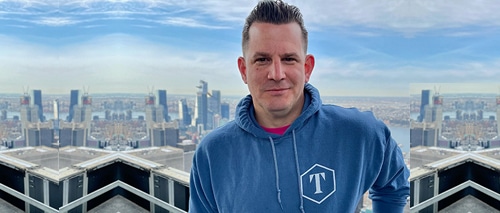
At Thompson Exterior Services, our team is made up of dedicated professionals who bring skill, passion, and collaboration to every project—working together to deliver lasting results.
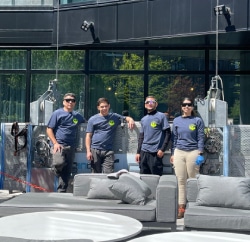
Thompson Exterior Services take pride in providing exceptional client service, and thus has maintained strong relationships through the years.
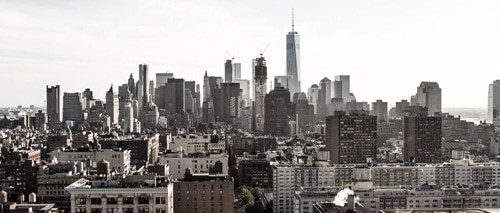
At Thompson Exterior Services, we’re looking for motivated individuals with the courage to take chances, and who understand that making a difference takes passion, patience, and persistence.
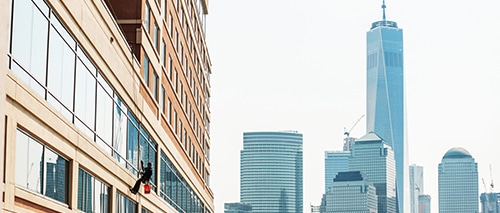
At Thompson Exterior Services, we’re looking for motivated individuals with the courage to take chances, and who understand that making a difference takes passion, patience, and persistence.
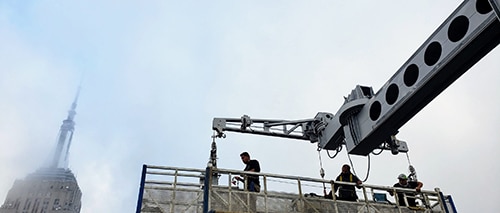
Check out our High-Rise Heroes newsletter on Linked In and subscribe there too!
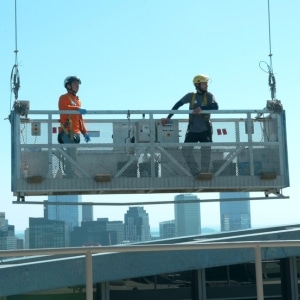
Our CEO, Josh Thompson, dives into the real challenges that buildings and commercial properties face every day.
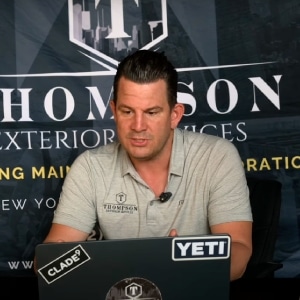
Our people are the heart of everything we do. Watch their story and hear their dedication to safe, quality work.
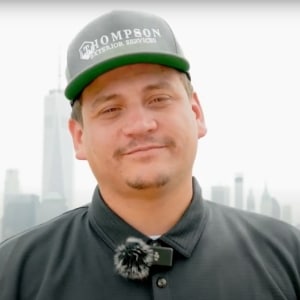
2171 Woodbridge Ave
Edison, NJ 08817
(732) 997-8138
2146 SW 38th St
Fort Lauderdale, FL 33312
(305) 563-5541
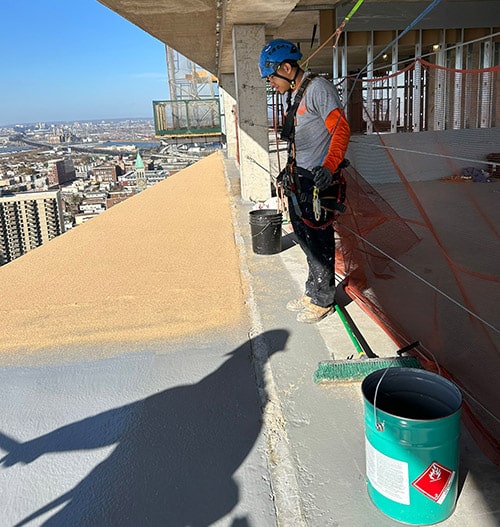

Fall protection is much more than beams, anchors and bolts. It is a complete system that has been engineered and designed for a specific application. Thompson Fall Protection offers fully compliant, custom tailored engineered personal fall arrest systems and Fall Protection Solutions in Hackensack, NJ. These practical turnkey solutions are designed for different structures, and in all types of industries.
From anchorages for single line suspension systems, like Rope Descent Systems (RDS), to systems for supporting powered platforms and roof cars, all installations are supervised, approved and stamped by a licensed professional engineer experienced in the design of fall protection systems.
Our Fall Protection Specialists in Hackensack, NJ team of professionals will work with you to evaluate your facility and then design a system that meets your needs, satisfies compliance issues, and protects your investment from liability.
Thompson exterior Inspects, Test Installs and certifies a wide range of fall arrest equipment, including horizontal lifelines, vertical lifelines, tie-backs, and personal protection equipment (PPE). We conduct our services according to OSHA 1910.140, OSHA 1910.28 and ANSI Z359 Standards. We can also perform inspections according NYDOL standards for our clients in Hackensack, NJ, respectively. We use several inspection methods and Safety Assessments for Buildings in Hackensack, NJ to verify equipment, including:
29 CFR OSHA 1910.27 And ANSI Standard both State that all roof anchors and façade access systems utilized as a rope descent system (RDS) need initial certification and testing prior to use as well as recertification once every 10 years (5 years for Chemically fastened anchors). Thompson Exterior – Reliable Fall Protection Services in Hackensack, NJ works with a network of licensed professional engineers to oversee all recertifications. Our technicians have extensive experience utilizing as well as inspecting and testing fall protection systems and components. We assess, Inspect and test all types of fall protection equipment as well as their structural attachment type for both Roof anchors and Davits.
A davit is a structurally connected base that serves as a primary anchor support for suspension platforms on buildings. OSHA Section 1910.66 requires that Building owners must receive PE Stamped certification after installing a davit system and must undergo davit systems recertification (Including load test) a minimum of every ten years.
We provide Advanced Fall Protection Engineering in Hackensack, NJ to ensure that our clients remain compliant with industry standards such as:
Staying compliant with these standards minimizes risk and helps our clients to ensure the safety of their personnel and investments.
Thompson Exterior understands the importance of recertification, Some of the services we provide our clients:
Horizontal lifelines, are an added component of a Roof anchor Durable Fall Protection Systems Hackensack, NJ , keeping workers safe by attaching them to a steel cable secured to a structural anchor point with shock absorber.
These anchors are permanent installations and can be configured in a variety of ways based on the work surface. Horizontal Lifelines are used to ensure safety when inspecting or performing maintenance actions on the roof near unprotected edges of a commercial or industrial property. Horizontal Lifelines Can be designed as fall restraint (prevents falls from happening) or fall arrest (provides safety to personnel if a fall takes place) .
The following are the most common:
Roof top anchors are an essential part of any system. Thompson offers a selection of High-Quality Fall Protection Equipment in Hackensack, NJ, roof top anchors which are compatible with various fall arrest connecting systems. No matter the slope or material of your roof, we have a solution for all environments and unique situations.
All roof anchors are constructed using a Patented 3/4-inch Stainless Steel U-Bar, welded to a structural steel tube. The entire anchor is Hot Dipped Galvanized on the interior and exterior surfaces. This ensures the most corrosive-resistant anchor available. This anchor comes in many configurations to match your building’s construction.
These roof anchors can also be coated in a high-visibility orange coating that provides easy identification and location for workers when excessive rooftop equipment is present. This coating is impact, UV and chemical resistant to provide years of maintenance-free service.
All wall series anchors are fabricated entirely from type 304 stainless steel. The Patented 3/4-inch U-Bar is welded to a stainless steel plate. All attachment hardware is also stainless steel. This ensures years of trouble-free service and eliminates unsafe and unsightly corrosion. This anchor is extremely economical and when installed in most walls requires no additional flashing costs.
Thompson Fall Protection is a complete turnkey provider of OSHA compliant roof and wall anchors systems. Contact us for expert assistance with your Hackensack, NJ Building Fall Safety Solutions.

Nobody wants a workplace accident. That’s why guardrails are a perfect protection system in Hackensack, NJ for your company. Whether you have a more permanent need for guardrail systems like a construction zone, a temporary need like sidewalk construction near your entrance, or a specialized need like regular roof access protection, Thompson Fall Protection in Hackensack, NJ is here to help with OSHA Compliant Fall Protection Hackensack, NJ.
Rooftop guardrail systems are a critical form of fall protection. Our guardrail systems can be fully customizable to fit your unique facility and come in a variety of permanent and temporary solutions; the most popular is the non-penetrating permanent railings. All of our roof systems are designed to meet or exceed OSHA regulations and can are easy to assemble on the surface of your roof.
With our roof guardrail systems, you can rest easy knowing that both your employees and your building are always safe and secure.
Thompson Fall Protection in Hackensack, NJ is a complete turnkey provider of OSHA compliant Roof guardrail systems. Contact us for expert assistance with your fall protection requirements.
Thompson Fall Protection offers a range of services in Hackensack, NJ related to non-destructive load testing of rooftop fall arrest anchors and davit arm assemblies. We use a load test protocol that is safe for your roof…and your anchor.
Our engineers make determinations about the strength of the anchor by reviewing the anchor and building drawings, as well as the geometry of the anchor itself. In addition, our inspectors spot potential problems like corrosion, bad welds, etc. via visual inspection.
Annual fall protection system inspection and re-certification is about more than just complying with OSHA regulations and ANSI standards. Engineered fall protection systems consist of a myriad of components that wear with usage, and unauthorized system modifications can put your employees-and your company-at risk. For all of these reasons, your fall protection system needs annual inspection and re-certification by a qualified person.
Each of our certified inspectors are trained to identify worn components and make any repairs required to ensure safe use of your system.
Inspection and re-certification are two phases of the annual review process. During an inspection, the safety engineer will determine if repairs and adjustments are needed to re-certify the system. If the system is found in good working order, then no repairs are required to re-certify. In other instances, repairs are needed before we can move forward with re-certification. We call this two-step process entire process “inspection for re-certification.”
Horizontal Lifeline Systems, also known as HLL systems, are utilized in many of the fall arrest and fall restraint systems. HLL’s are used primarily for restraint of the technician on the roof and or the ledge when performing necessary tasks. They solve a very real problem and can allow safe access to areas that would be potentially deadly if a fall would to occur, by limiting access to the fall. Horizontal lifelines are common Fall Protection Solutions in Hackensack, NJ work areas that lack existing anchor points for personnel tie–off.
These systems can run short distances or even up to hundreds of feet with the proper intermediate posts for support. HLL’s are designed to fit the very specific conditions of each site and require proper engineering designs. Traditional tie back anchors can also be incorporated into the system to allow suspended access work and fall arrest capabilities.
When used in combination with personal protective equipment, a horizontal lifeline can arrest a fall, limiting the amount of force that is transferred both to the worker and the fall arrest systems. This same combination of horizontal lifeline, body harness, and lanyard can also serve as a fall restraint system, limiting the the worker’s ability to move close enough to fall over an unprotected leading edge. The fall restraint and fall arrest properties of horizontal lifelines make the HLL an integral part of many Fall Protection Systems in Hackensack, NJ.
The main function of a Davit Arm is support for suspended scaffold systems. They can be short or tall depending on the parapet wall conditions, or may even allow the scaffold to raise high enough to clear the wall and swing the unit onto the roof. Some have very large outreach to clear obstacles below such as balconies or cornices.
We also design davit arms for hauling material to upper levels and can incorporate lifting devices to assist with this. Davit Arms are almost always designed to fit the particular buildings requirements and can be fabricated to fit most new construction and existing Hackensack, NJ buildings.
Thompson Fall Protection is a complete turnkey provider of OSHA compliant davit arms systems. Contact us for expert assistance with your fall protection requirements in Hackensack, NJ.
Swing stage scaffolds are perhaps the most common type of suspended scaffold. Hung by ropes or cables connected to stirrups at each end of the platform, they are typically used by window washers and construction workers on skyscrapers without permanent access.
Anchorage: The safe use of a suspended scaffold begins with secure anchorage. The weight of the scaffold and its occupants must be supported by both the structure to which it is attached and by each of the scaffold components that make up the anchorage system.
A tieback is a taut wire rope “tied-back” to an anchorage capable of supporting 5,000 pounds to secure rigging equipment like parapet hooks or counterweighted outriggers. The purpose of a tieback is to prevent inadequately counterweighted outriggers from falling off the roof, or to prevent parapet hooks from falling in the event of parapet failure.
Thompson Exterior Services partners with American Anchor to deliver industry-leading façade access and fall protection solutions, ensuring every project meets the highest standards of safety and compliance. Together, we provide innovative systems designed to keep buildings accessible, protected, and legally compliant.
One example is the installation of monorail systems which is a specialized track system that allows suspended equipment, such as window cleaning platforms or inspection rigs, to move smoothly along the building’s façade. This permanent, engineered solution not only maximizes safety for workers but also provides efficient access to challenging building exteriors. Whether it’s fall protection, façade access, or custom system installs, Thompson Exterior Services and American Anchor keep your building covered, literally and legally.
Photo and video credit: @AmericanAnchor.USA
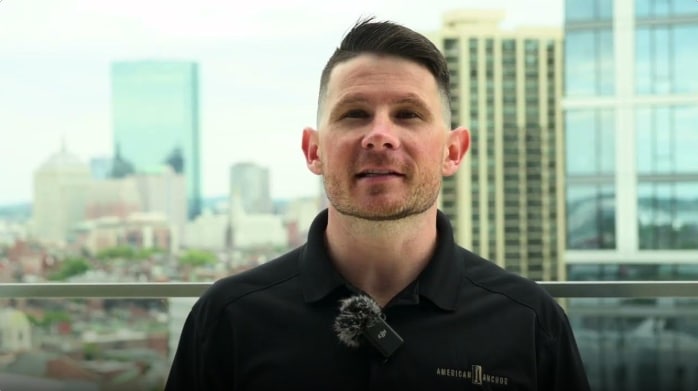
We believe in a job well done. Proper safety practices are a key part of that. Take the necessary precautions with a safety net and safety netting accessories. Thomson Fall Protection in New York, NY offers safety nets and debris containment nets to maintain safety for your workers and the general public. These products are easy to install, simple to use and require low maintenance.
OSHA compliant – exceeds 200 lbs. lateral force if properly installed by a qualified professional and will meet or exceed the following standards/regulations:
*ANSI/ASSE A10.11-1989 (R1998)
*OSHA 1926.451 g4 (ix)
*NYC Local Law 61 including reference standard 19-4 10.8 & 10.9
Fiber Content: High Density Polyethylene – UV Treated
Fire Retardant Standard: Meets NFPA 701 Method II original and after 72 HRS leaching & Boston Fire Marshal FR Standard (independently tested). Classification Fire Test – BFD1X-1.
In compliance with OSHA standards 1910.27 and 1910.28, building owners who want to have their windows cleaned must show documentation proving they’ve had window washing anchors installed and that these devices meet all requirements. Proof of documentation ensures the building owners provide safety measures for the workers.
After the building is constructed, the responsibility for window washing anchors shifts to the building owner, as they are required to have the anchors inspected annually and complete a 5-10 year certifications. Regularly checking the anchors’ condition ensures they are safe for workers.
In fact, in the OSHA Anchorage Requirements for Rope Descent Systems 1910.27(b)(1)(i), it now requires that before “employers use a rope descent system, the building owner must inform the employer in writing that the building owner has identified, tested, certified, and maintained each anchorage so it is capable of supporting 5,000 pounds in any direction, for each worker attached”. The new regulations also require that the building owner base the information provided to the employer on:
The Occupational Safety and Health Administration standard, 29 CFR 1910.28 Safety requirements for scaffolding applies to the scaffolding application you described. Under paragraph 1910.28(a)(28), scaffolds must be secured to permanent structures, through the use of anchor bolts, reveal bolts or other equivalent means. Window cleaners’ anchor bolts shall not be used. Also, under paragraph 1910.28(a)(2), the anchorage for scaffolds must be sound, rigid and capable of carrying the maximum intended load without settling or displacement. The employer of workers who use the temporary scaffolding installation you described is responsible for ensuring that the aforementioned scaffolding requirements are met.
Under paragraph 1910.66(g)(2), building support structures covered, by paragraph 1910.66(e) must undergo periodic inspection by a competent person at intervals not exceeding 12 months. Under paragraph 1910.66(d) Definitions, competent person means a person because of training and experience, is capable of identifying hazardous or dangerous conditions in powered platform installations and of training employees to identify such conditions.
Failure to provide the proper fall protection can result in severe financial penalties for your business. OSHA notified regional administrators January 2019, The memo stated that the new maximum penalty for a Serious violation is $13,260.00 and upwards of $14,000.

"*" indicates required fields
"*" indicates required fields
"*" indicates required fields